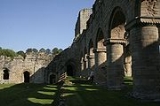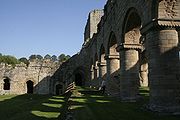
Buildwas Abbey
Encyclopedia
Buildwas Abbey is located along the banks of the River Severn
in Buildwas
, Shropshire
, England
, about two miles west of Ironbridge
.
, Bishop of Coventry
(1129–1148) as a Savignac
monastery and was inhabited by a small community of monks from Furness Abbey
. The stone from which it was built was quarried in the nearby settlement of Broseley
.
The abbey's location near the border of Wales
meant it was destined to have a turbulent history. Welsh Princes and their followers regularly raided the Abbey, and on one occasion in 1406 raiders from Powys
even kidnapped the abbot
. This however paled in comparison to an event in 1342 where one of the Buildwas monks, Thomas Tong, murdered his abbot, managed to evade arrest and then petitioned for re-instatement into the Cistercian order.


during the Dissolution of the Monasteries
, whereupon the estate was granted to Edward Grey, 3rd Baron Grey of Powis
.
and are open to the public, who can view the church which remains largely complete and unaltered since its original construction, although it is now without its roof.
The remains are considered to be among some of the best preserved twelfth-century examples of a Cistercian church in Britain.
River Severn
The River Severn is the longest river in Great Britain, at about , but the second longest on the British Isles, behind the River Shannon. It rises at an altitude of on Plynlimon, Ceredigion near Llanidloes, Powys, in the Cambrian Mountains of mid Wales...
in Buildwas
Buildwas
Buildwas is a village and civil parish in Shropshire, England, on the north bank of the River Severn at . It lies on the B4380 road to Atcham. The Royal Mail postcodes begin TF6 and TF8Buildwas Primary School is situated on the Buildwas bank road...
, Shropshire
Shropshire
Shropshire is a county in the West Midlands region of England. For Eurostat purposes, the county is a NUTS 3 region and is one of four counties or unitary districts that comprise the "Shropshire and Staffordshire" NUTS 2 region. It borders Wales to the west...
, England
England
England is a country that is part of the United Kingdom. It shares land borders with Scotland to the north and Wales to the west; the Irish Sea is to the north west, the Celtic Sea to the south west, with the North Sea to the east and the English Channel to the south separating it from continental...
, about two miles west of Ironbridge
Ironbridge
Ironbridge is a settlement on the River Severn, at the heart of the Ironbridge Gorge, in Shropshire, England. It lies in the civil parish of The Gorge, in the borough of Telford and Wrekin...
.
Early history
The Cistercian Abbey of St Mary and St Chad was founded in 1135 by Roger de ClintonRoger de Clinton
Roger de Clinton was a medieval Bishop of Coventry and Lichfield. He was responsible for organising a new grid street plan for the town of Lichfield in the 12th century which survives to this day.-Life:...
, Bishop of Coventry
Bishop of Coventry
The Bishop of Coventry is the Ordinary of the England Diocese of Coventry in the Province of Canterbury. In the Middle Ages, the Bishop of Coventry was a title used by the bishops known today as the Bishop of Lichfield....
(1129–1148) as a Savignac
Congregation of Savigny
The monastic Congregation of Savigny started in the abbey of Savigny, situated in northern France, on the confines of Normandy and Brittany, in the Diocese of Coutances. It originated in 1105 when Vitalis of Mortain established a hermitage in the forest at Savigny in France.-Founding:Vitalis was a...
monastery and was inhabited by a small community of monks from Furness Abbey
Furness Abbey
Furness Abbey, or St. Mary of Furness is a former monastery situated on the outskirts of the English town of Barrow-in-Furness, Cumbria. The abbey dates back to 1123 and was once the second wealthiest and most powerful Cistercian monastery in the country, behind only Fountains Abbey in North...
. The stone from which it was built was quarried in the nearby settlement of Broseley
Broseley
Broseley is a small town in Shropshire, England with a population of 4,912 . The River Severn flows to the north and east of the town. Broseley has a town council and is part of the area controlled by Shropshire Council. The first iron bridge in the world was built in 1779 to link Broseley with...
.
The abbey's location near the border of Wales
Wales
Wales is a country that is part of the United Kingdom and the island of Great Britain, bordered by England to its east and the Atlantic Ocean and Irish Sea to its west. It has a population of three million, and a total area of 20,779 km²...
meant it was destined to have a turbulent history. Welsh Princes and their followers regularly raided the Abbey, and on one occasion in 1406 raiders from Powys
Powys
Powys is a local-government county and preserved county in Wales.-Geography:Powys covers the historic counties of Montgomeryshire and Radnorshire, most of Brecknockshire , and a small part of Denbighshire — an area of 5,179 km², making it the largest county in Wales by land area.It is...
even kidnapped the abbot
Abbot
The word abbot, meaning father, is a title given to the head of a monastery in various traditions, including Christianity. The office may also be given as an honorary title to a clergyman who is not actually the head of a monastery...
. This however paled in comparison to an event in 1342 where one of the Buildwas monks, Thomas Tong, murdered his abbot, managed to evade arrest and then petitioned for re-instatement into the Cistercian order.


Closure
The abbey was closed in 1536 by the order of Henry VIIIHenry VIII of England
Henry VIII was King of England from 21 April 1509 until his death. He was Lord, and later King, of Ireland, as well as continuing the nominal claim by the English monarchs to the Kingdom of France...
during the Dissolution of the Monasteries
Dissolution of the Monasteries
The Dissolution of the Monasteries, sometimes referred to as the Suppression of the Monasteries, was the set of administrative and legal processes between 1536 and 1541 by which Henry VIII disbanded monasteries, priories, convents and friaries in England, Wales and Ireland; appropriated their...
, whereupon the estate was granted to Edward Grey, 3rd Baron Grey of Powis
Baron Grey of Powis
This article is about Baron Grey of Powis. For the title Baron Powis, see Earl of Powis.thumbThe Baron Grey of Powis title was created for the great-grandson of Joan Charleton , co-heiress and 6th Lady of Powis and her husband, Sir John Grey, 1st Earl of Tankerville after the death of Joan's...
.
Modern history
The abbots house and infirmary were later incorporated into the building of a private house in the 17th century for the Acton Moseley family, although the remaining buildings are now in the care of English HeritageEnglish Heritage
English Heritage . is an executive non-departmental public body of the British Government sponsored by the Department for Culture, Media and Sport...
and are open to the public, who can view the church which remains largely complete and unaltered since its original construction, although it is now without its roof.
The remains are considered to be among some of the best preserved twelfth-century examples of a Cistercian church in Britain.

